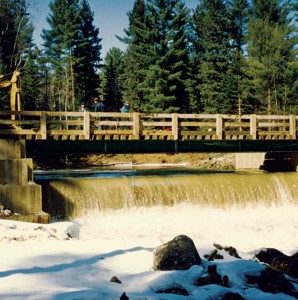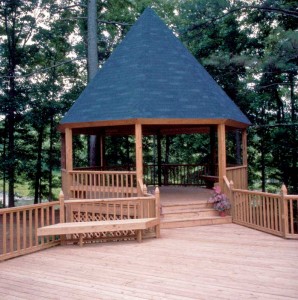Pressure-treated Wood: A new look at a traditional product

Borate preservatives
Borates are a more recent addition to the preservatives available for pressure treatment of wood. Wood treated with borates is used in protected or interior construction applications––lumber for fascia and trim, and plywood for wall and roof sheathing and subfloors. While very effective, borates’ water solubility requires the treated wood be used in applications not exposed to wetting.
It is important to note wood preservatives are classified as pesticides and, as such, are regulated under the Pest Control Products Act administered by Health Canada’s Pest Management Regulatory Agency (PMRA). All pesticide products, including wood preservatives, must obtain a registration from PMRA to be sold and used in Canada. To obtain a registration, each pesticide must go through an extensive data review covering all aspects of human health/safety, environmental fate, and efficacy. If PMRA deems the pesticide acceptable, the product receives a registration label.
Organo-metallic preservatives
In 2003, the industry voluntarily withdrew CCA from the market for most residential treated wood products to facilitate the introduction of the new organo-metallic preservatives––alkaline copper quaternary (ACQ) compounds and copper azole (CA). These produce a green-coloured wood product with an appearance and benefits similar to those of CCA-treated wood, but without the arsenic and chrome components.
ACQ and CA have gained wide acceptance in the residential marketplace since their introduction in 2004. Retailers across Canada carry a range of products, including:
- dimension lumber;
- plywood;
- posts;
- landscape ties;
- lattice;
- spindles; and
- stair stringers.
In fact, CAN/CSA-O80 Series-08, Wood Preservation, used by specifiers, now includes numerous other applications for ACQ- and CA-treated wood, including highway guardrail posts.

and copper azole (CA) have gained acceptance for outdoor projects like decking and gazebos.
The introduction of ACQ and CA initially created some confusion in the retail sector because the change in preservative formulations required closer adherence to recommended standards for fasteners and connectors. The new formulations are more alkaline than CCA and, as a result, are more corrosive to metal. Within a short time, Canadian retailers were able to correctly source the proper materials, and no issue exists today when the proper fasteners/connectors are used.
Re-evaluating wood preservatives
In 2011, PMRA completed a re-evaluation of the traditional heavy-duty wood preservatives including CCA, ACZA, creosote, and PCP. The re-evaluation was an extensive process conducted in conjunction with the U.S. Environmental Protection Agency (EPA)—
the registration authority in the United States. All aspects of the preservatives (including health/safety, environmental effects, and efficacy) were examined. The re-evaluation’s outcome supported the continued use of these preservatives primarily in the industrial/commercial or agricultural applications listed earlier. Some residential applications for CCA remained, including permanent wood foundations and shingles/shakes.
This year has seen changes in the residential pressure-treated wood market as the next generation of new wood preservatives are being launched. Making its way into the market this year is a carbon-based wood preservative that is colourless and gives the treated wood a natural appearance without the customary green colour of most other residential treated wood preservatives. Wood treated with this preservative is limited to use in above-ground applications.
Also poised to enter the Canadian market is micronized copper azole (MCA). Sub-micron particles are physically deposited in the wood cells in solid form without the use of solvents, fixing to the wood like a coating. Wood treated with MCA can be used both above ground and in ground contact. It can range in colour from a pale green to natural brown and cedar shades.

Wood preservation certification
In 2005, Wood Preservation Canada launched the Canadian Wood Preservation Certification Authority (CWPCA) to monitor compliance to Environment Canada’s Technical Recommendations Document (TRD) for the Design and Operation of Wood Preservation Facilities 2004. This document outlines in great detail the means by which treated wood producers must design and operate their facilities to protect plant employees and the environment. The requirements are state-of-the-art and were developed through the collaborative efforts of industry, labour, Environment Canada, and Health Canada. More than 220 criteria are examined on an annual basis through an internal audit subjected to third-party external review. Additionally, an external third-party audit is conducted every three years to ensure compliance.
The CWPCA program is a major success story; it now includes 53 of the 54 treating plants currently operating in Canada. Certification requires a minimum 90 per cent compliance to the TRD depending on the preservative type used. In most plants, compliance is 95 per cent or more, with several scoring 100 per cent. Most retailers require CWPCA certification as part of their sourcing requirements. Many specifiers also request CWPCA certification in their purchasing process.
The industry is continuing to work with the regulators to update the TRD to include new preservatives and technologies as they are introduced. A new edition is expected to be completed by the end of this year.

For treating plants using the traditional wood preservatives––CCA, ACZA, creosote, and PCP––compliance to the TRD will become mandatory next year as a result of the PMRA re-evaluation. With the industry’s support, PMRA will include a requirement for TRD compliance on product registrations so only certified plants can use these preservatives in Canada.
Conclusion
It is virtually impossible to go anywhere in Canada and not encounter some sort of pressure-treated wood product in service.
Through wood preservation, people can continue to benefit from the use of Canada’s most renewable building material. Extending wood’s service life lessens the demand on the forests. Indeed, the beauty of wood as a construction material is enhanced by the science of wood preservation.
Henry Walthert, CAE, is the executive director for Wood Preservation Canada. He has more than 25 years of experience in the wood preservation industry. Walthert holds a bachelor of science in forestry and a bachelor of education from the University of Toronto (U of T). He serves as chair of Canadian Standards Association (CSA) A366 Wood Preservation and Technical Committee and secretary of International Organization for Standardization (ISO) TC 165/SC1 Wood Material–Durability and Preservation. Walthert is a member of the Canadian Wood Preservation Association (CWPA), American Wood Protection Association (AWPA), International Group on Wood Protection (IRG), and Canadian Society of Association Executives (CSAE). He can be reached via e-mail at henry@woodpreservation.ca.







